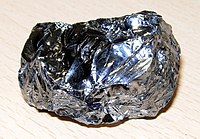
Photo from wikipedia
Abstract Traditionally, preparing p-type (Bi,Sb)2Te3 based materials by the combination of ball milling and hot pressing is regarded effective to reduce the lattice thermal conductivity and obtain high zT value.… Click to show full abstract
Abstract Traditionally, preparing p-type (Bi,Sb)2Te3 based materials by the combination of ball milling and hot pressing is regarded effective to reduce the lattice thermal conductivity and obtain high zT value. However, the deteriorated electrical transport properties and poor reproducibility restrict the further promotion of such technology. In this work, we prepare Bi0.4Sb1.6Te3 materials with Te self-compensation method, which leads to a high average zT value of 1.39 from 30 to 200 ℃ with significantly enhanced reproducibility. The Te self-compensation is found to be effective in manipulating the B i ( S b ) Te - and V Te 2 + native defects in Bi0.4Sb1.6Te3 and thus suppress the “donor-like” effect caused by ball milling. The resulting enhanced carrier concentration further brings about a convergence of multi-valley bands, which leads to an increase in the density of states (DOS) near Fermi level and delays the onset of bipolar effect, in favor of improving electrical properties meanwhile reducing the bipolar thermal conductivity. Moreover, in the melting process, the excess Te facilitates the formation of Te-rich precipitates which remain in the ball-milled powders and then volatilize during the spark plasma sintering (SPS) process, thus leaving dispersedly distributed submicron pores and concequently reduced the lattice thermal conductivity. Taken together, the peak zT value reaches 1.55 at 100 ℃ and shows excellent reproducibility in three repeated measurements, which can promote the widespread application of the ball-milled (Bi,Sb)2Te3 based materials in solid-state refrigeration.
Journal Title: Chemical Engineering Journal
Year Published: 2021
Link to full text (if available)
Share on Social Media: Sign Up to like & get
recommendations!